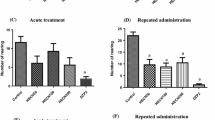Abstract
An increasing number of observations indicate that prostaglandin synthesis inhibition is not a satisfactory explanation for the antinociceptive activity of the non-steroidal anti-inflammatory drugs.
In the hot-plate test performed 1 or 2 h after ketorolac at 40, 70 and 100 mg/kg i.p., the drug does not display any significant antinociceptive activity. Nor, at the two higher doses used, does it affect the cortical and pontine serotonin binding capacity of rat brain membranes 2 h after treatment. The data suggest that this lack of antinociceptive activity in the hot-plate test is associated with the drug's inability to affect the central serotoninergic system.
Similar content being viewed by others
References
R. K. S. Lim,Pain. Ann. Rev. Physiol.32, 269–288 (1970).
J. R. Vane,Inhibition of prostaglandin synthesis as a mechanism of action for aspirin-like drugs. Nature New Biol.231, 232–235 (1971).
R. J. Flower and J. R. Vane,Inhibition of prostaglandins synthetase in brain explains the anti-pyretic activity of paracetamol (4-acetaminophenol). Nature New Biol.240, 410–411 (1972).
K. Brune, K. D. Rainsford, K. Wagner and B. Peskar,Inhibition by anti-inflammatory drugs of prostaglandin production in cultured macrophages. Factors influencing the apparent drug effects. Naunyn-Schmiedeberg's Arch. Pharmacol.315, 269–276 (1981).
K. McCormack and K. Brune,Dissociation between the antinociceptive and anti-inflammatory effects of the non-steroidal anti-inflammatory drugs. Drugs41, 533–547 (1991).
S. Hunskaar,Similar effects of acetylsalicylic acid and morphine on immediate responses to acute noxious stimulation. Pharmacol. Toxicol.60, 167–170 (1987).
K. Brune, W. S. Beck, G. Geisslinger, S. Menzel-Soglowek, B. M. Peskar and B. A. Peskar,Aspirin-like drugs may block pain independently of prostaglandin synthesis inhibition. Experientia47, 257–261 (1991).
S. V. Abramson and G. Weissman,The mechanism of action of non-steroidal anti-inflammatory drugs. Arth. Rheum.32, 1–9 (1989).
M. G. Buzzi, D. E. Sakas and M. A. Moskowitz,Indomethacin and acetylsalicylic acid block neurogenic plasma protein extravasation in rat dura mater. Eur. J. Pharmacol.165, 251–258 (1989).
C. J. Woolf,Central and peripheral components of hyperalgesia that follows peripheral tissue injury. In:Development, Organization and Processing in Somato-sensory Pathways. (Eds. M. Rowe and W. D. Willis) pp. 317–323, Alan R. Liss Inc., New York 1985.
K. W. Shyu and M. T. Lin,Hypothalamic monoaminergic mechanisms of aspirin-induced analgesia in monkeys. J. Neural. Trans.62, 285–288 (1985).
L. Gelgor, S. Cartmell and D. Mitchell,Intracerebroventricular micro-injections of non-steroidal anti-inflammatory drugs abolish reperfusion hyperalgesia in the rat's tail. Pain50, 323–329 (1992).
S. Okuyama and H. Aihara,The mode of action of analgesic drugs in adjuvant arthritic rats as an experimental model of chronic inflammatory pain: Possible central analgesic action of acidic nonsteroidal antiinflammatory drugs. Jap. J. Pharmacol.35, 95–103 (1984).
I. Jurna and K. Brune,Central effect of the non-steroidal anti-inflammatory agents indomethacin, ibuprofen and diclofenac determined in C fibre-evoked activity in single neurons of the rat thalamus. Pain41, 71–81 (1990).
P. I. Wood,Animal models in analgesic testing In:Analgesics: Neurochemical, Behavioral and Clinical Perspectives (Eds. M. Kuhar and G. Pasternak) pp. 175–193, Raven Press, New York 1984.
A. Groppetti, P. C. Braga, G. Biella, M. Parenti, L. Rusconi and P. Mantegazza,Effect of aspirin on serotonin and metenkephalin in brain: Correlation with the antinociceptive activity of the drug. Neuropharmacology27, 499–505 (1988).
J. Pascual,Serotonin, serotonin receptors, serotonin receptor subtype agonists and pain. Pain40, 115–116 (1990).
G. Kobal, C. Hummel, B. Neurnberg and K. Brune,Effects of pentazocine and acetylsalicylic acid on pain-rating, pain-related evoked potentials and vigilance in relationship to pharmacokinetic parameters Agents and Actions29, 342–359 (1990).
J.-P. Wand and C.-M. Teng,Effects of anti-inflammatory drugs on rat hind-paw swelling caused by phospholipase A2 from Naja Naja Atra venom. Naunyn-Schmiedeberg's Arch. Pharmacol.344, 377–381 (1991).
L. A. Pini, G. Vitale and M. Sandrini,Brain serotonin binding capacity, analgesia and drug serum levels after acute treatment with phenazone in rats. Pharmacol. Res.25 (2S), 258–259 (1992).
M. M.-T. Buckley and R. N. Brodgen,Ketorolac. A review of its pharmacodynamic and pharmacokinetic properties, and therapeutic potential. Drugs39, 86–109 (1990).
H. W. H. Rooks, P. J. Maloney, L. D. Shott, M. E. Schuler and H. Sevelius,The analgesic and anti-inflammatory profile of ketorolac and its tormethamine salt. Drugs Exp. Clin. Res.11, 479–492 (1985).
C. S. Campbell, P. Krumpe and J. Shepard,Ventilatory effects of ketorolac and morphine in chronic obstructive pulmonary disease. Drug Invest.5, 1–10 (1993).
M. Zimmermann,Ethical guidelines for investigation of experimental pain in conscious animals. Pain16, 109–110 (1983).
L. S. Harris and A.-K. Pierson,Some narcotic antagonists in the benzomorphan series. J. Pharmacol. Exp. Ther.143, 141–145 (1964).
J. P. Bennet and S. H. Snyder,Serotonin and lysergic acid diethylamide binding in rat brain membranes: Relationship to postsynaptic serotonin receptors. Mol. Pharmacol.12, 373–389 (1976).
G. Scatchard,The attraction of proteins for small molecules. Ann. N.Y. Acad. Sci.51, 660–664 (1949).
M. Sandrini, G. Vitale, E. Sternieri, A. Bertolini and L. A. Pini,Effect of chronic treatment of phenazone on the hot-plate test and [3H]-serotonin binding sites in pons and cortex membranes in the rat. Pharmacology47, 84–90 (1993).
L. A. Pini, G. Vitale and M. Sandrini,The role of serotonin brain receptors in the analgesic effect of phenazone. Drugs Exp. Clin. Res.19, 13–17 (1993).
Author information
Authors and Affiliations
Rights and permissions
About this article
Cite this article
Vitale, G., Sandrini, M. & Pini, L.A. Lack of activity of ketorolac in hot-plate test and serotonin binding capacity of brain membranes in rats. Agents and Actions 41, 184–187 (1994). https://doi.org/10.1007/BF02001914
Received:
Accepted:
Issue Date:
DOI: https://doi.org/10.1007/BF02001914



